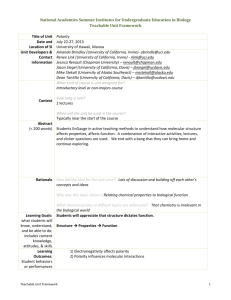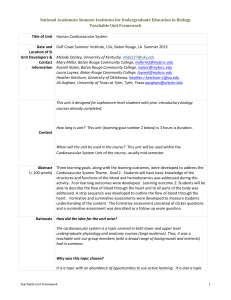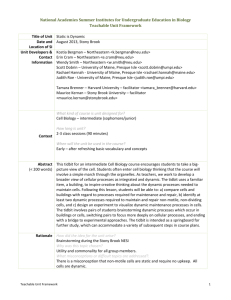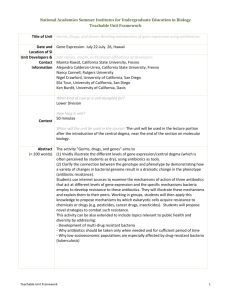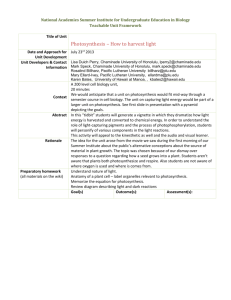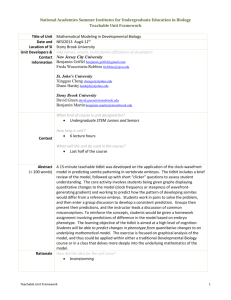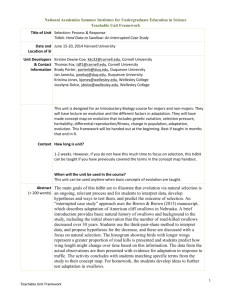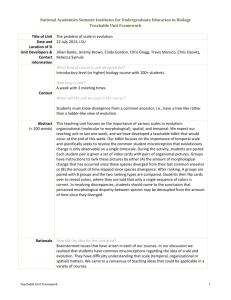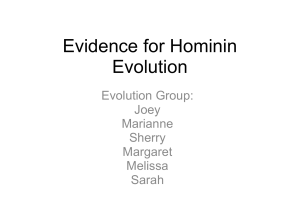Cells on the Move (framework) Northeast 2013
advertisement
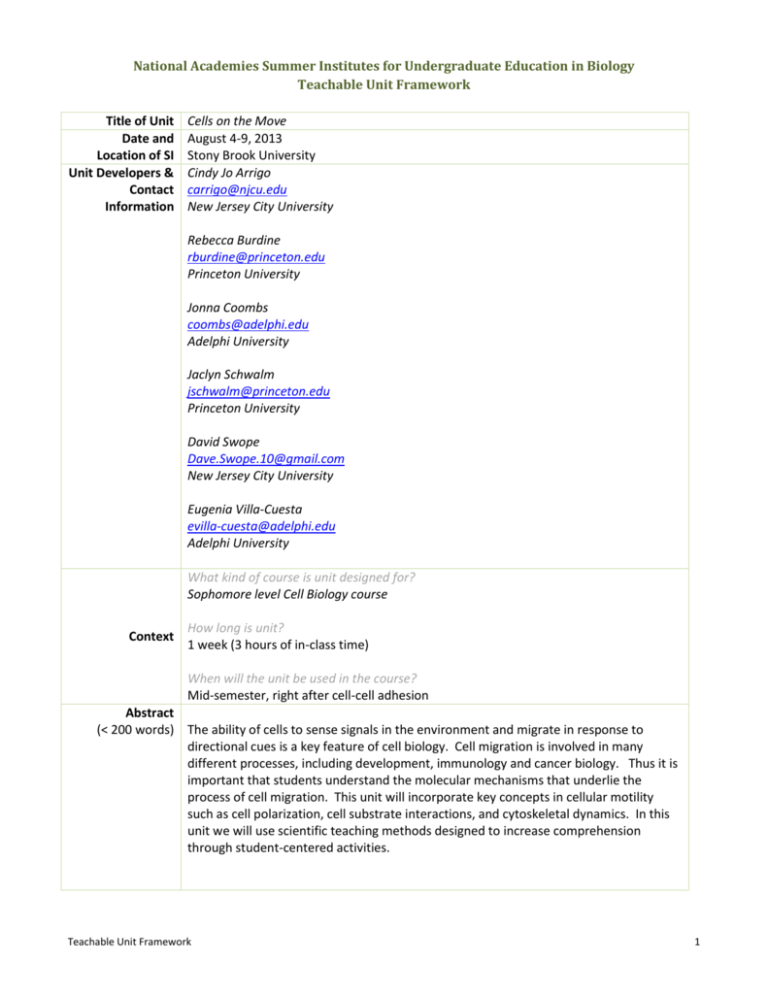
National Academies Summer Institutes for Undergraduate Education in Biology Teachable Unit Framework Title of Unit Date and Location of SI Unit Developers & Contact Information Cells on the Move August 4-9, 2013 Stony Brook University Cindy Jo Arrigo carrigo@njcu.edu New Jersey City University Rebecca Burdine rburdine@princeton.edu Princeton University Jonna Coombs coombs@adelphi.edu Adelphi University Jaclyn Schwalm jschwalm@princeton.edu Princeton University David Swope Dave.Swope.10@gmail.com New Jersey City University Eugenia Villa-Cuesta evilla-cuesta@adelphi.edu Adelphi University What kind of course is unit designed for? Sophomore level Cell Biology course Context How long is unit? 1 week (3 hours of in-class time) When will the unit be used in the course? Mid-semester, right after cell-cell adhesion Abstract (< 200 words) The ability of cells to sense signals in the environment and migrate in response to directional cues is a key feature of cell biology. Cell migration is involved in many different processes, including development, immunology and cancer biology. Thus it is important that students understand the molecular mechanisms that underlie the process of cell migration. This unit will incorporate key concepts in cellular motility such as cell polarization, cell substrate interactions, and cytoskeletal dynamics. In this unit we will use scientific teaching methods designed to increase comprehension through student-centered activities. Teachable Unit Framework 1 National Academies Summer Institutes for Undergraduate Education in Biology Teachable Unit Framework Rationale How did the idea for the unit arise? The group brainstormed topics in Cell and Developmental Biology that were deemed important for students in a sophomore level class. Themes and connections emerged, such that the brainstorming list became less a list and more a network. Topic choices were narrowed down based on what group members could apply in their classes and what topics the group members felt that students would be most interested in and benefit from. Why was this topic chosen? A topic was chosen that incorporated several of the ideas that had been discussed and would be applicable to the different courses (and course levels) of the group participants. Learning Goals: what students will know, understand, and be able to do; includes content knowledge, attitudes, & skills What misconceptions or difficult topics are addressed? 1.) Cells that move and then attach are attached for life 2.) The dynamic nature of the cytoskeleton is a difficult topic for most students 3.) Cells don’t need to adhere to a substrate (i.e. surface) to migrate Goals: 1.) Students should understand how migratory cells sense and respond to environmental cues 2.) Students should understand how migratory cells become polarized 3.) Students should know how cells interact with and move on their substrates 4.) Understand the importance of cell migration in development and disease Learning Outcomes: Student behaviors or performances that will indicate they have successfully accomplished the goals Teachable Unit Framework 1.) Students should be able to describe a ligand-receptor pathway that can direct cell migration and explain a potential consequence of dysregulation of that pathway 2.) Students should be able to create a diagram illustrating 3 cytoskeletal differences between a polarized migrating cell vs. a non-migrating cell 3.) Students should be able to compare and contrast cell matrix interactions at the leading an lagging ends of a migratory cell 4.) Students should be able to design an experiment to determine if a specific signal acts as a directional cue 5.) Students should be able to evaluate developmental and disease processes for the importance of cell migration. 2 National Academies Summer Institutes for Undergraduate Education in Biology Teachable Unit Framework Incorporation of Scientific Teaching Themes Active Learning How students will engage actively in learning the concepts Assessment How teachers will measure learning; how students will selfevaluate learning Diversity How the unit is designed to include participants with a variety of experiences, abilities, and characteristics Activities outside of class: Homework is included in our unit, which asks the students to research an example of cell migration that interests them, to describe it, and to include its importance. This will require the students to actively engage outside of class, and because they are asked to choose an area that interests them, the topic will be more meaningful. Pre-assessments: Students will have been assessed previously on their knowledge of the concepts covered in the cell migration unit. The unit includes a number of different types of active learning. In addition, a picture of a diverse group of individuals could be included on the slide with the question about experimental design, and we described the team as international. We were also aware that if an individual is color-blind, they may be unable to see the color in our fluorescent image, and addressed that verbally. Finally, group work may help to include a number of individuals with diverse characteristics. Activities in class: Students are asked to design an experiment to determine whether a signal is indeed a directional cue. Then, students are asked to take part in a think-pair-share activity in which they choose which component of cellular migration would be best to target to eliminate metastasis in this cancer. This requires students to think creatively and synthesize what they have learned (or what they will learn) about cell migration, as well as provides the students with a real-world application of the topic. Post-tidbit assessments: Students could be asked to turn in their experimental diagrams. In addition, the think-pair-share activity could be performed using clickers or other interactive tools, in order to assess whether the students understood the concept. Finally, the students’ homework can be assessed, either by the instructor/TA or by their peers. Activities during tidbit: See activities in class above. Teachable Unit Framework 3 National Academies Summer Institutes for Undergraduate Education in Biology Teachable Unit Framework Sample Presentation Plan (general schedule with approximate timing for unit) Session 1 Time Learning Outcome(s) (min) Preclass 1. Students should be able to describe a ligandreceptor pathway that can direct cell migration and explain a potential consequence of dysregulation of that pathway 2. Students should be able to create a diagram illustrating 3 cytoskeletal differences between a polarized migrating cell vs. a non-migrating cell 3. Students should be able to compare and contrast cell matrix interactions at the leading an lagging ends of a migratory cell A few This tidbit is meant to minutes bring together and show for review. the importance of material covered previously throughout the unit. Approx. 7- 4. Students should be 10 able to design an minutes. experiment to determine if a specific signal acts as a directional cue 5. Students should be able to evaluate developmental and disease processes for the Teachable Unit Framework Activity/assessment Explanation, notes, suggestions, tips Students will have been assessed to determine their ability to reach these learning outcomes in previous lectures. Assessment will have been performed previously to ensure that the students have the ability to perform learning goals 13. Class is asked to act as an See notes on Powerpoint slides international team for activity. working at a pharmaceutical company, and to design an experiment to show that an isolated protein is a directional cue (see Powerpoint slide). 4 National Academies Summer Institutes for Undergraduate Education in Biology Teachable Unit Framework importance of cell migration. Students are asked to diagram their experiment and share with the class. Controls, techniques, outcomes, etc. are discussed. 4. Students should be able to design an experiment to determine if a specific signal acts as a directional cue 5. Students should be able to evaluate developmental and disease processes for the importance of cell migration. Students are asked to choose a target for a potential therapeutic (see Powerpoint slide). They are then asked to perform a think-pair-share activity, and answers are discussed. See notes on Powerpoint slide for activity. A few 5. Students should be minutes. able to evaluate developmental and disease processes for the importance of cell migration. This activity is expected to sum up the cell migration unit, so transition would be to the next learning unit. Students will be assigned homework to ensure that they have the ability to perform the final learning outcome. See notes on Powerpoint slide for tips and scoring rubric. Approx. 5 minutes Add additional activities information as needed for the unit. Resources for Teaching the Unit All of the notes, handouts, questions, and slides are contained within the Powerpoint file for this unit. Teachable Unit Framework 5 National Academies Summer Institutes for Undergraduate Education in Biology Teachable Unit Framework Effectiveness of unit (if you have used it in your own teaching) Acknowledgements We want to acknowledge our facilitator, David Gross, for all of his helpful comments and suggestions. We also want to acknowledge the other attendees at NESI 2013 for their participation and helpful feedback in shaping the unit. Teachable Unit Framework 6

